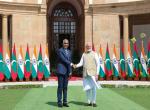Since the past few days, various Indian media agencies have been covering the statements released by the National Investigation Agency (NIA) about the involvement of a few Muslim youths with Daesh or Islamic State of Iraq and Syria (ISIS). Not only did NIA expose the influence of this terror outfit in the country but it also dispelled certain myths, particularly of Madrasas being the major platform from where radicalization is taking place. In the details shared by this intelligence agency during its raising day celebration recently, 80 percent of all of the suspected Daesh operatives who were arrested in 2016 had “formal schooling” while the remaining 20 percent had gone to Madrasa. This revelation has clearly highlighted the phenomenon which is prevalent in the global context where hundreds of thousands of people from numerous countries, belonging to different age groups, have succumbed to the radicalization tactics and are eventually recruited into groups like Daesh. This pattern is also seen in Pakistan where a bulk of people joining jihadist groups have been from non-Madrasa background and indoctrination happened in public schools. Why such phenomenon has started in India is a question that is left to be answered.
It is a known fact that since the past few years, many of the foreign fighters from non-West Asian countries, who received proper education, have left their employments in their respective countries and joined the ongoing jihad in West Asia, particularly in Syria. India, too, witnessed a similar trend when Daesh-related activities were at its peak between mid-2014 and 2016. Moreover, as it is in the West, some of the arrestees (India) have been converted from either Christianity or Hinduism. However, the numbers of those arrested (Indians) or who are still serving in Syria/Iraq are significantly less as compared to European and Southeast Asian countries, for instance. After remaining in denial during the initial days that Indian Muslims are well integrated into the mainstream society, subsequent arrests and reports of youths travelling to conflict zones dispelled the myth that they are immune to Daesh’s propaganda as well as radicalizing and recruiting tactics. It also became clear that geographical barrier is not anymore a roadblock which could prevent them from travelling to the so-called caliphate in Syria/Iraq. Despite these gradual developments, India has been fortunate that it has not faced any untoward incident either directed or inspired by Daesh thanks to the painstaking effort of the law enforcement agencies which are coordinating not only with the state governments but also with the center. On the other hand, the rising attacks in Europe painted a different picture of the involvement of their citizens who fought in the ranks of Daesh and returned home, and that of continuing threats from domestically radicalized lone individual and extremists.
The tables below gives some statistics with regard to Daesh-related activities in India in the last couple of year. The information has been compiled from various media reports.
Table 1 gives the age group of Indians who were arrested and it is in consonance with that of foreign fighters who flocked to West Asia.
| Age Group (in years) | No. of People Arrested |
|---|---|
| 18-25 | 28 |
| 25-40 | 20 |
| Above 40 | 4 |
Table 2 indicates the schools of thought to which the youths, particularly the arrestees, have been allegedly subscribed to.
| School of Thought | Percentage |
|---|---|
| Ahle Hadith | 50 |
| Tablighi Jamaat | 30 |
| Deobandis | 20 |
The study conducted by the NIA gives an idea of the types of school of thought and their ideologies which are attributed to radicalization of the arrestees and other similarly influenced people. The followers of Ahle Hadith, in particular, are those who follow puritanical form of Islam which are mostly found in countries like Saudi Arabia. That the majority of the youths arrested adhered to this school fit well into the commonly seen experience where practices of Islam — Wahabism, in particular—being imported from abroad are instrumental in indoctrinating several impressionable youths not only India but the world over. There is a similar phenomenon in Bangladesh and Maldives as well which are witnessing mushrooming of several sponsored mosques, often funded by the Gulf countries, particularly Saudi Arabia, and this has significantly contributed to spreading radical ideologies.
Needless to say that states such as Maharashtra, Kerala, Telangana and West Bengal are increasingly becoming fertile grounds for radicalization on theological basis while others, including Uttar Pradesh, Tamil Nadu, Rajasthan, Madhya Pradesh, Jammu and Kashmir and Rajasthan, are also gradually following the trend. These states, worryingly, have already witnessed Daesh-linked activities followed by arrests. Although it is clear, to an extent, where radicalization in the recent times is mostly prevalent, it is imperative to unearth the platforms from where lessons from different schools of thought are taught, who the ideologues or the preachers are, and importantly, their interpretations. The presence of such influential individuals, who often operate from the shadows, is augmenting the process of radicalization and also facilitate recruitment into terror outfits. In the light of this, the arrests are undoubtedly a commendable breakthrough but threats from radicalized people who remain undetected will continue to remain in the country and are unlikely to dissipate anytime soon.
Some of the current discussions over the perceived decline of Daesh influence is accentuated by looking at the military crackdown in Syria and Iraq where the outfit is on the back foot. Undeniably, the outfit’s leadership and fighters have apparently lost their vigor to prevent their territories from being recaptured by the coalition security forces, but not their ability to give orders to stage brazen attacks like the ones in Paris and Brussels in 2015 and 2016, respectively. What, however, remains a worrisome factor is the presence of extremely radicalized and zealous supporters and sympathizers who, time and again, have exhibited their prowess to attack anywhere, particularly in Western nations. Attacks in the future need not be directly linked to Daesh but the possibilities of people using its brand should not be ignored. In most cases, such individuals lie low and are undetectable. As it is, some of the Indians who were arrested after their return to India reportedly planned ‘lone-wolves’ sort of attacks and they maintained contacts with Daesh-handlers situated in West Asia. Arrests of Subahani Haja Moideen in October 2016, and that of West Bengal-based Mohammad Masiuddin alias Abu Musa, against whom NIA filed a charge-sheet, are examples of such cases. What was of concern in the latter case was the revelations about his connections with leaders of Jamaat-ul-Mujahideen Bangladesh (JMB) and his desire to kill foreigners in India. The NIA charge-sheet mentioned that “the accused entered into a criminal conspiracy to carry out terrorist activities by way of robbing, raping, killing, and beheading members and servants of one influential and well to do family to publicize the presence of the ISIS in India and to spread terror among the people in India”.
Daesh has successfully franchised its ‘ideas’ not only in ideological sense but also in operational tactics — where to attack, whom to attack, what kinds of weapons are appropriate and when to attack! There is a clear link between the modus operandi of Daesh and the recent incidents in Berlin, Istanbul and a few American cities. In other words, the concept of ‘inspired attacks’ will continue to make Daesh relevant event after it is defeated militarily, sooner or later.
In India, the problem of radicalization is unlikely to be tackled anytime soon, and this will definitely go in favor of those people who are constantly on the search for vulnerable yet potential recruits - this does not have to be only for Daesh. Moreover, the narratives for radicalization are also changing. Earlier, Syrian humanitarian crisis, ambition of establishing an Islamic State in a particularly territory, etc., were some of the radicalizing and recruiting factors but the outfit has now tried to invoke anti-state sentiments by referring to the “violence against Muslims in many places, including Mumbai, Gujarat, Assam and Moradabad.” This had happened at a time when the country was witnessing rising cases of radicalized Muslim youths who are either allegedly travelling to Syria or are planning operations by remaining in the country last year. Simultaneously, the call to take terror back to home intensified after Daesh started losing its territories which led to the crumbling of its ‘caliphate dream’.
How much ever may one continue to belittle the poison of radical narratives such as ‘Islam is in danger’ and ‘Muslims are severely oppressed and marginalized’, these are going to remain an inevitable part of radicalization. Motivation for martyrdom to these vengeful youths still runs high no matter how the attributed factors for such act are dismissed. As long as there are networks which are assisting these people, their potentialities to create unrest should not be undermined. But unless the problem of radicalization is tackled from the grass-root level, India will continue to face threats.









